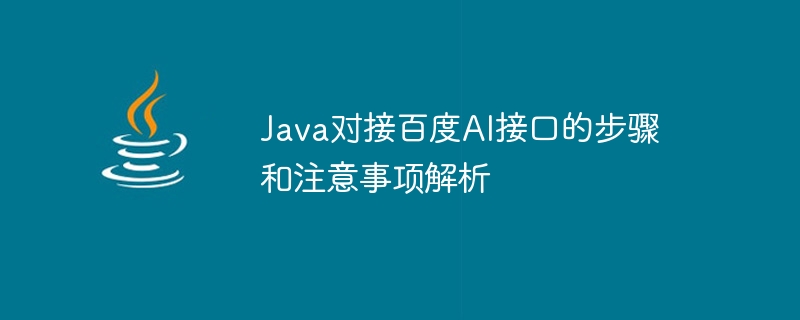

Analysis of steps and precautions for connecting Java to Baidu AI interface
Introduction:
With the development of artificial intelligence technology, Baidu AI platform provides various This kind of AI interface can be applied in various fields. Java is a mainstream programming language, and many developers hope to use Baidu AI interfaces in Java projects to implement various functions. This article will guide readers step by step to understand the steps of connecting Java to Baidu AI interface and what needs to be paid attention to, and give corresponding code examples.
1. Apply for a Baidu AI developer account
First, we need to apply for a developer account on the Baidu AI open platform and create an application to obtain the API Key and Secret Key. These two keys are the key to our authentication in the Java project and access to Baidu AI interface.
2. Import Baidu AI Java SDK
Baidu AI officially provides Java SDK. We can import Baidu AI's Java SDK through build tools such as Maven or Gradle. The following is an example of using Maven to import the Java SDK:
com.baidu.aip java-sdk 4.7.0
3. Write Java code to connect to the Baidu AI interface
In the Java code, we need to complete the following steps to connect to the Baidu AI interface:
import com.baidu.aip.client.AipClient; public class AipDemo { public static final String APP_ID = "your_app_id"; public static final String API_KEY = "your_api_key"; public static final String SECRET_KEY = "your_secret_key"; public static final AipClient client = new AipClient(APP_ID, API_KEY, SECRET_KEY); }
import com.baidu.aip.imageclassify.AipImageClassify; import org.json.JSONObject; public class AipDemo { public static final String APP_ID = "your_app_id"; public static final String API_KEY = "your_api_key"; public static final String SECRET_KEY = "your_secret_key"; public static final AipClient client = new AipClient(APP_ID, API_KEY, SECRET_KEY); public static void main(String[] args) { // 创建AipImageClassify对象 AipImageClassify imageClassify = client.newAipImageClassify(); // 调用图片分类接口 JSONObject result = imageClassify.objectDetect("your_image_path", new HashMap()); // 处理返回结果 System.out.println(result.toString()); } }
4. Precautions
In the process of using Java to connect to Baidu AI interface, you need to pay attention to the following issues:
Conclusion:
This article introduces the steps and matters needing attention for connecting Java to Baidu AI interface, and gives corresponding code examples. I hope this article will be helpful to readers who are learning and using Java to develop Baidu AI interface, and can successfully complete the task of docking Baidu AI interface.
The above is the detailed content of Analysis of steps and precautions for connecting Java to Baidu AI interface. For more information, please follow other related articles on the PHP Chinese website!
